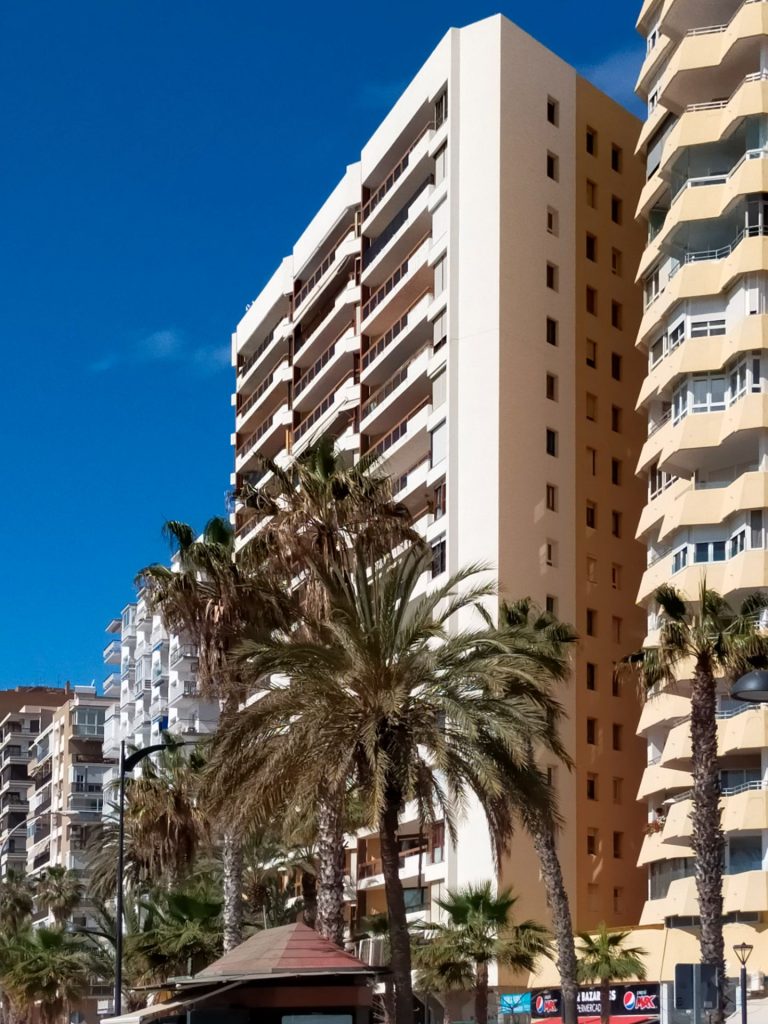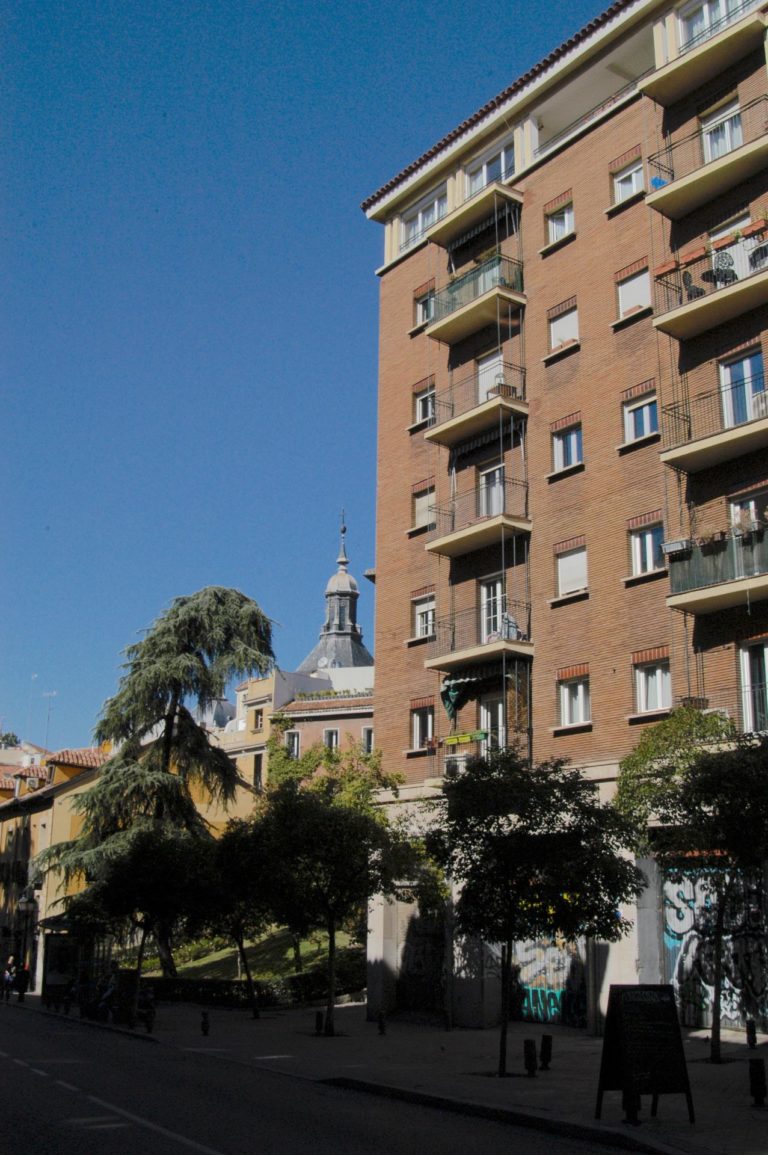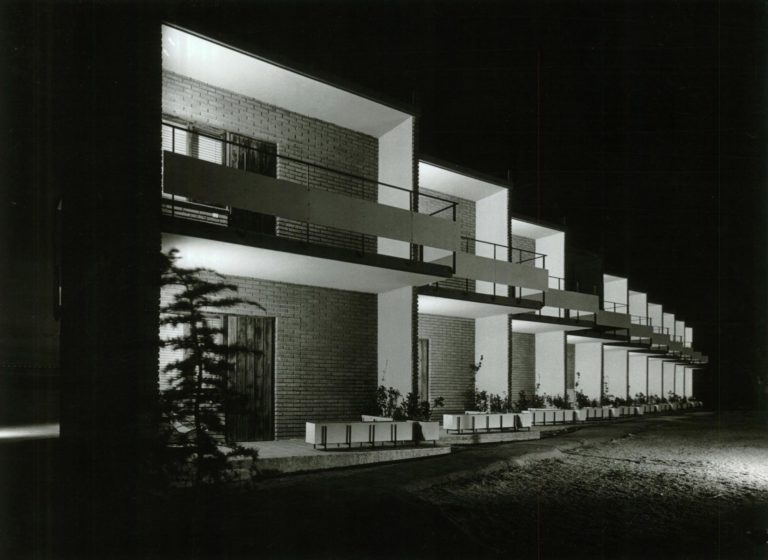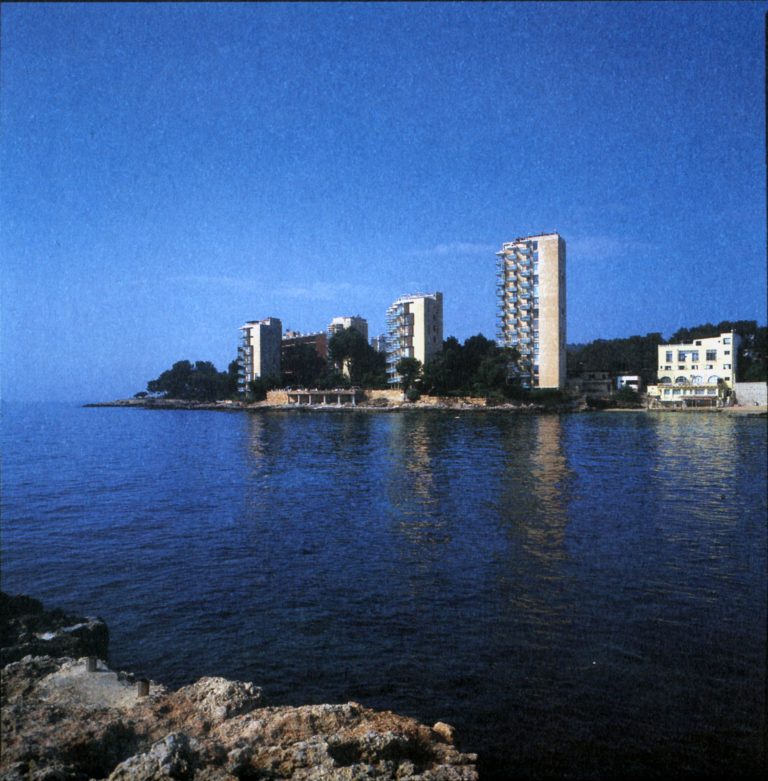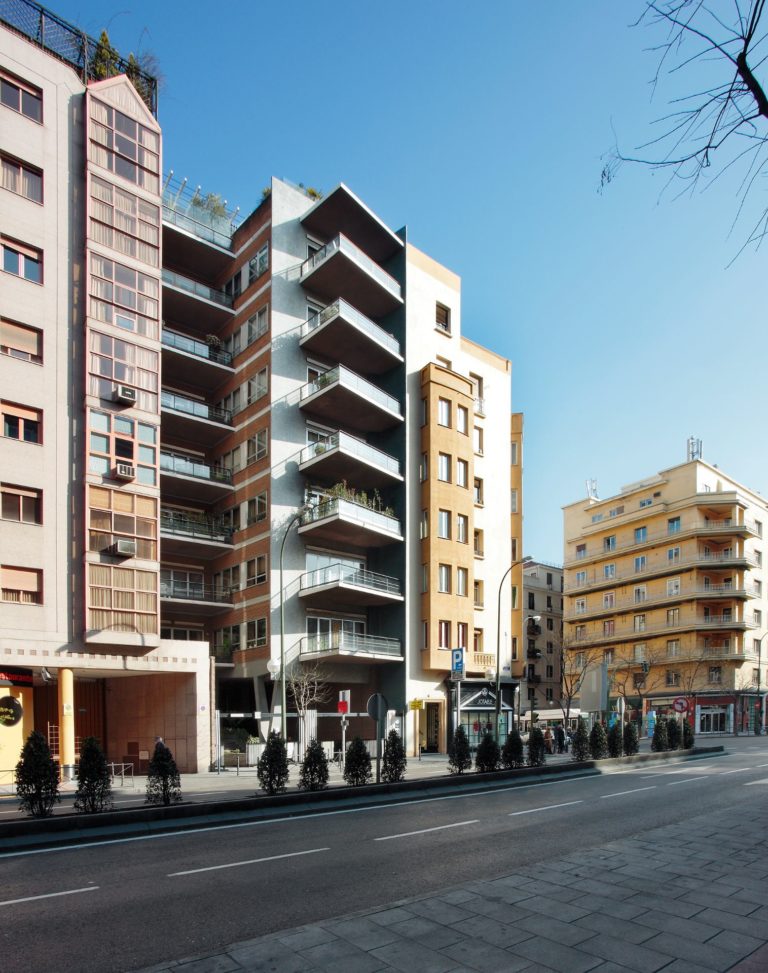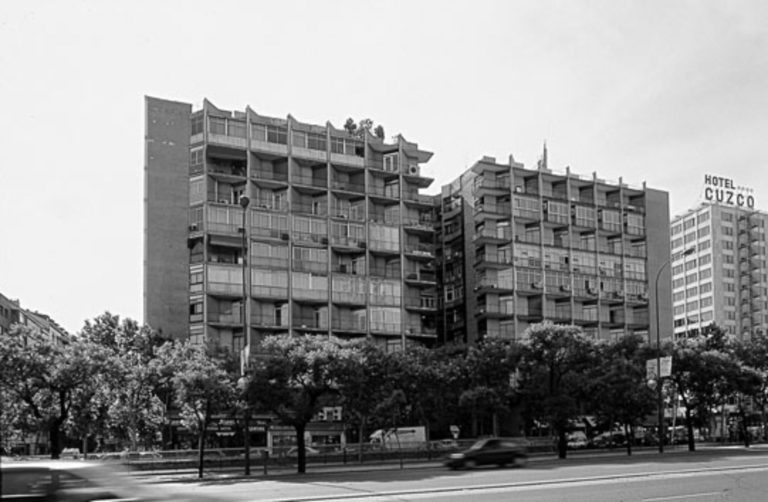
Antonio Lamela Martínez
Madrid, 1926-2017
Antonio Lamela Martínez earned his degree in architecture from the Madrid school in 1954 and began what would be a long professional career that same year. In 1959, he received his doctorate from the same university.
His studio, which is still fully operational under the direction of his son Carlos, also an architect, is one of the largest in Spain and has completed more than 1,000 projects over its history.
This immense body of work, realized throughout Spain and abroad, began with Spain’s economic growth in the 1960s, derived from new tourist initiatives and the occupation of the coast. Drawing on an awareness of territorial issues and environmental impact, Lamela’s approaches always maintained a balanced understanding between his architecture and the surroundings, with exemplary projects in Mallorca and the Costa del Sol, as well as several hotels for the Meliá chain. Likewise, his residential constructions – from the large scale, such as the San Ignacio de Loyola neighbourhood and the Galaxia complex, both in Madrid, to single-family homes – demonstrate a distinct functional commitment to the society that uses the architecture. The most interesting technical innovations of his career include the suspended structure in the Torres Colón and the unbuilt Eurocis complex, both of which were designed in a more technical phase of his career, along with the bank building on calle Génova and the La Pirámida offices on Paseo de la Castellana, all in Madrid.
A professional who maintained great precision in his designs, Lamela was an exacting builder and structural innovator, and his architecture draws on a deep knowledge of materials and technical construction processes.
These ethical values and mastery of design are combined admirably in his work, which demonstrates the rare quality of offering a balance between the strictest functionality and service to society, and an intense aesthetic sense within the modern movement.
Antonio Lamela is represented in the Docomomo Ibérico Registry by 10 buildings, including notable residential projects such as the block where he lived on calle O’Donnell in Madrid and the multi-family building on Paseo de la Castellana. Likewise, he has been recognized for his holiday architecture, with the Meliá hotel in Madrid and the Motel El Hidalgo in Valdepeñas (Ciudad Real) and several significant blocks of holiday flats, such as the Apartamentos Rocamarina in Calvià, Mallorca, and the block on the Paseo Marítimo in Malaga.
He served as a guest professor at numerous national and foreign universities, most importantly at the Menéndez Pelayo International University in Santander, the summer sessions at El Escorial, the University of Alicante, and the University of Seville in Marbella. His theoretical contributions include the creation of two new sciences: “Cosmoism” and “Geoism”. Likewise, he acted as director of curricula for the Madrid School of Architecture and for the School of Urban Planning at the Camilo José Cela University in Madrid. He was awarded an honorary doctorate from the latter university and became a full member of the Royal Academy of PhDs in Madrid.
Recognition of his work includes the designation of Universal Spaniard by the Independent Foundation of Madrid, the Plaque for Touristic Merit, the Medal for Professional Merit awarded by the Spanish Polytechnic Federation of Graduates, the Communication and Public Relations Award from Madrid, the Grand Cross of the Order of Civil Merit, the Gold Medal for Merit in Work, the King James I Award for Urban Planning, Landscape and Sustainability, and the Gold Medal from the CEMA Environment Club. For the new Terminal 4 of the Madrid airport, realized in collaboration with the British firm of Richard Rogers, he received the RIBA European Award, the Stirling Prize, and the Airports Council International Award.
Biography by Alberto Sanz
Bibliography
- FERNÁNDEZ-GALIANO, Luis, Maestros españoles, Arquitectura Viva, Madrid, 2021.
- LAMELA, Carlos, “Arquitectura e innovación [online]: las claves de la obra de Antonio Lamela y Estudio Lamela: su aportación a los siglos XX y XXI”, in Informes de la Construcción 553, Instituto de Ciencias de la Construcción Eduardo Torroja, Madrid, January-March 2019.
- FERNÁNDEZ-GALIANO, Luis, “La construcción realista: Antonio Lamela, Madrid (1926-2017”, in Arquitectura Viva 195, Madrid, 2017, pp. 50-51.
- ESTEBAN, Concha, Antonio Lamela y Torres Colón: historia de una de las realizaciones más relevantes de la arquitectura y la ingeniería estructural del siglo XX, General de Ediciones de Arquitectura, Valencia, 2017.
- “Estudio Lamela: 60 años de historia de la arquitectura”, in NAN Negocio a Negocio: arquitectura y construcción 86, TPI Edita, Madrid, octubre de 2013, p. 54.
- VARAS VILACHÁN, Lucas Manuel, “Antonio Lamela: el arquitecto es un instrumento social”, in NAN Negocio a Negocio: arquitectura y construcción 87, TPI Edita, Madrid, November 2013, pp. 36-40.
- TORRES MCCRORY, Álvaro de, “Antonio Lamela: humanista y arquitecto”, in Arquitectos de Madrid 8, Colegio Oficial de Arquitectos, Madrid, December 2009, pp. 40-46.
- LÓPEZ-JAMAR, Eduardo, “Antonio y Carlos Lamela”, in NAN Negocio a Negocio: arquitectura en construcción, Madrid, TPI Edita, 47, November 2009, pp. 24-30.
- LAMELA MARTÍNEZ, Antonio, Tres sesiones sobre arquitectura, T6 Ediciones, Escuela Técnica Superior de Arquitectura, Universidad de Navarra, Pamplona, 2009.
- MUÑOZ BLANCO, Mónica, “Antonio Lamela: arquitecto, académico y Premio Jaime I”, in Mercados de las Infraestructuras y la Construcción 19, Mercados de las Infraestructuras y la Construcción, Madrid, June 2009, pp. 14-15.
- LAMELA MARTÍNEZ, Antonio, “Ciudad y salud”, in AA VV, Antonio Lamela [prólogo de Joao Pontífice], Fundación Sanofi-Aventis, Madrid, 2006.
- MARTÍNEZ DE LUKO y AGUIRRE, José María, En la construcción vale todo…? / [prólogo de Antonio Lamela], El Instalador, Madrid, 2006.
- RAMÍREZ, Lola, “Antonio Lamela: arquitecto, académico y fundador del Estudio Lamela”, in El Inmobiliario mes a mes 47, Cerezo Comunicaciones, Madrid, October 2005, pp. 124-125.
- Premios de Arquitectura Piedra 2004, Federación Española de la Piedra Natural, Madrid, 2005.
- “Antonio Lamela: más de cincuenta años de profesión”, in NAN, TPI Edita, Madrid, 2 May 2005, pp. 68-77.
- AA VV, Proyectos y Realizaciones 1990-2005, Xarait Ediciones, Madrid, 2005.
- LAMELA MARTÍNEZ, Antonio, “La Sostenibilidad, un reto global ineludible = Sustainability, an inescapable global challenge”, in Informes de la Construcción 499-500, Instituto Eduardo Torroja, Madrid, September-December 2005, pp. 55-65.
- RISPA, Raúl, Lamela: 1954-2005, Madrid, Ministerio de la Vivienda, Sevilla, Tanais, 2005.
- AA VV, Lamela 1954-2005, Editorial Tanais, Madrid, 2005.
- RISPA, Raúl, Estudio Lamela: arquitectos, Tanais/Estudio Lamela, Madrid/Sevilla, 2005.
- “Entrevista D. Antonio Lamela = Interview with Antonio Lamela”, in Menhir 3, Publicaciones Menhir, Bilbao, July 2001, pp. 72-79.
- FLORES, Mónica, “Antonio Lamela Martínez”, in Menhir 3, Bilbao, Publicaciones Menhir, July 2001, pp. 68-71.
- MARGITIC, Elidia, Lamela: Urbanística y Arquitectura Realizaciones y Proyectos 1954-1992, Xarait Ediciones, Madrid, 1992.
- BASABE, Juan, “Antonio Lamela, arquitecto: entrevista”, in BIA 45, Colegio de Aparejadores y Arquitectos Técnicos, Madrid, December 1981, pp. 10-12.
- LAMELA MARTÍNEZ, Antonio, Torres Colón, Madrid, 1978.
- LAMELA MARTÍNEZ, Antonio, Cosmoísmo y geoísmo, Editora Nacional, Madrid, 1976.
- LAMELA MARTÍNEZ, Antonio, “La Ciudad del futuro”, in Cercha, Madrid, Colegio Oficial de Aparejadores del Centro, 13, Second semester 1974, pp. 55-56.
- LAMELA MARTÍNEZ, Antonio, El Neo-mudéjar: las Torres de Colón y su ambiente, Colegio Oficial de Arquitectos de Madrid, Madrid, 1971.
- “Antonio Lamela: pionero de las estructuras colgadas en España y arquitecto de la verdad”, Arte y cemento 902, 1970.
- “Antonio Lamela, pionero de las estructuras colgadas en España y arquitecto de la verdad”, in Arte y Cemento 902, October 1970, pp. 43-58.
